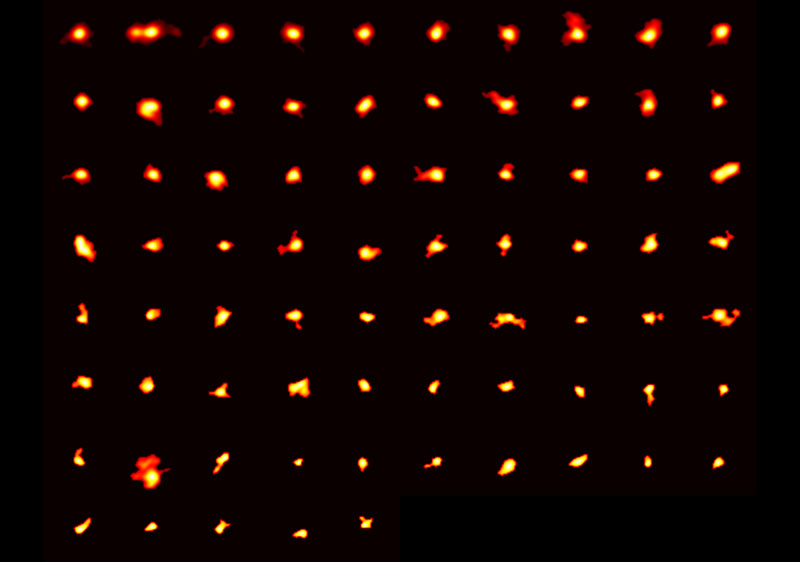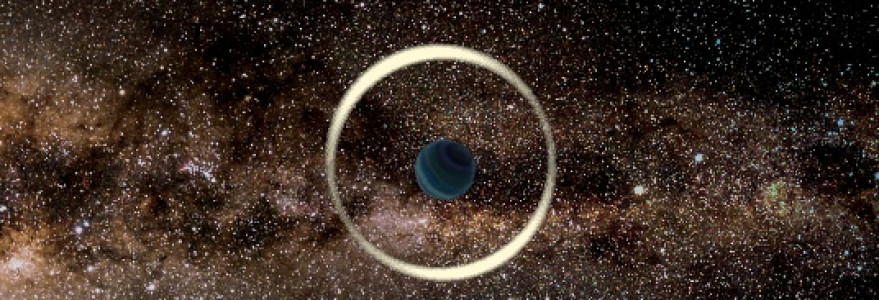This week in astronomy news: Distant galaxies that look older than they are and a terrestrial planet that might be drifting through our galaxy.
Young Galaxies Surprisingly Mature

O. Fevre e t al. / Astronomy & Astrophysics
The universe experienced a baby boom — baby stars, that is — about 3 billion years after the Big Bang. But new studies are showing that long before star formation peaked, galaxies were already churning out stars at prodigious rates, and changing their environments as they did so.
The ALMA Large Program to Investigate (ALPINE) has gauged the dust, gas, and star formation present in 118 distant galaxies.
The observations show that even when the universe was only 1–1.5 billion years old, galaxies’ starbirth was already half-obscured in dust clouds, suggesting that dust was building up even faster than astronomers would have predicted.
That’s surprising because dust takes time to make — any atoms heavier than hydrogen and helium have to be forged in stars first. “We didn’t expect to see so much dust and heavy elements in these distant galaxies,” said ALPINE co-principal investigator Andreas Faisst (Caltech).
ALPINE observations also show that these youngsters were “unruly”: The team classified 40% of the galaxies as mergers. Yet, at the same time, another 11% of the galaxies were stable rotating disks. These orderly galaxies confirm what some observations had already shown — that a number of galaxies stabilize into disks early on, even as others appear more chaotic and swirly from previous or ongoing mergers.
Read more about the studies in eight papers appearing October 27th in Astronomy & Astrophysics or in the National Radio Astronomical Observatory’s press release.
Potentially Rogue Planet Revealed

Jan Skowron / Astronomical Observatory / University of Warsaw
Young planetary systems aren’t orderly places. Gravitational interactions knock worlds around like billiard balls, typically with more massive planets kicking smaller ones to different orbits or out of the system altogether.
So astronomers expect lots of small planets to be wandering the galaxy. Actually spotting them is a different story, though — these objects are dark, and they don’t have a host star to wiggle or transit.
But that doesn’t mean they’re invisible. The Optical Gravitational Lensing Experiment (OGLE) surveys millions of stars in the Milky Way looking for the rare moments when celestial spheres align: Earth, planet, and background star. Then the world can make itself known, as its gravity momentarily magnifies the background star’s light.
Using this method, called microlensing, the OGLE survey has now found the smallest potentially rogue world to date, a planet with a mass somewhere between that of Mars and Earth. Its distance is unknown. The team spotted it by the 42-minute-long brightening of a background star — the shortest-known microlensing event yet. The Korea Microlensing Telescope Network provided additional observations.
Because alignment has to be just so, it could be that this planet has a host star — but if it does, the planet must orbit at least 8 astronomical units (a.u.) away. For comparison, Saturn never comes closer than 9.1 a.u. to the Sun. So if this world belongs to a star, it’s likely too far away to warm the planet much. Then again, our close look at Pluto, which is on average about 40 a.u. from the Sun, found unexpected geological activity, so who knows what this world — rogue or not — might hold.
Read more in the November 1st Astrophysical Journal Letters and in the University of Warsaw’s press release.
 3
3









Comments
Dennis-McCarthy
November 2, 2020 at 10:36 am
If these rogue objects don't orbit a star, and don't have a "neighborhood" to clear, should they be called "rogue dwarf planets" instead?
You must be logged in to post a comment.
Monica YoungPost Author
November 2, 2020 at 3:25 pm
Haha, touche! But the IAU definition of planet (vs dwarf planet) actually only applies to the solar system: https://www.iau.org/public/themes/pluto/ (scroll down to "The Final Resolution"). We don't have a standardized definition of planet for outside the solar system yet. After all, it's tricky to define something you can't directly see!
You must be logged in to post a comment.
Dennis-McCarthy
November 5, 2020 at 4:21 pm
Maybe "dark planets"?
You must be logged in to post a comment.
You must be logged in to post a comment.